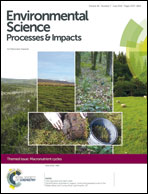Difference in production routes of water-soluble organic carbon in PM2.5 observed during non-biomass and biomass burning periods in Gwangju, Korea
Abstract
4 h integrated PM2.5 samples were collected from an urban site of Gwangju, Korea, for five days and analyzed for organic carbon and elemental carbon (OC and EC), total water-soluble OC (WSOC), hydrophilic and hydrophobic WSOC fractions (WSOCHPI and WSOCHPO), oxalate, and inorganic ionic species (sodium (Na+), ammonium (NH4+), potassium (K+), calcium (Ca2+), magnesium (Mg2+), chloride (Cl−), nitrate (NO3−), and sulfate (SO42−)) to investigate the possible sources of water-soluble organic aerosols. Two types of sampling periods were classified according to the regression relationship between black carbon (BC) concentrations measured at wavelengths of 370 nm (BC370nm) and 880 nm (BC880nm) using an aethalometer; the first period was traffic emission influence (“non-biomass burning (BB) period”) and the second was biomass burning influence (“BB period”). The slope of the regression equation (BC370nm/BC880nm) was 0.95 for the non-BB period and 1.29 for the BB period. However, no noticeable difference in the WSOC/OC ratio, which can be used to infer the extent of secondary organic aerosol (SOA) formation, was found between the non-BB (0.61, range = 0.43–0.75) and BB (0.61, range = 0.52–0.68) periods, due to significant contribution of primary BB emissions to the WSOC. The concentrations of OC, WSOC and K+, which were used as the BB emission markers, were 15.7 μg C m−3 (11.5–24.3), 9.4 μg C m−3 (7.0–12.7), and 1.2 μg m−3 (0.6–2.7), respectively, during the BB period, and these results were approximately 1.7, 1.7, and 3.9 times higher than those during the non-BB period. During the non-BB period, good correlations among WSOC, SO42− and oxalate, and poor correlations among WSOC, EC, and K+ suggest that SOA is probably an important source of WSOC (and WSOCHPI) concentration. For the WSOC fractions, better correlations among WSOCHPI, oxalate (R2 = 0.52), and SO42− (R2 = 0.57) were found than among WSOCHPO, oxalate (R2 = 0.23), and SO42− (R2 = 0.20), suggesting that a significant proportion of the WSOCHPI fraction of OC could be produced through processes (gas-phase and heterogeneous oxidations) such as SOA formation. However, during the BB period, the BB emission source accounted for the high correlations between total WSOC (and WSOC fractions) and other relevant atmospheric parameters (EC, Na+, Cl−, K+, and oxalate), with higher correlations in WSOCHPI than in WSOCHPO. These results suggest a significant contribution of BB emissions to WSOC.


 Please wait while we load your content...
Please wait while we load your content...